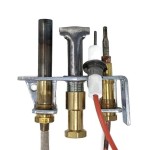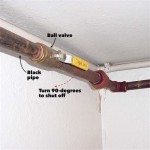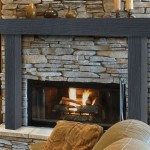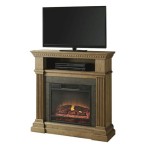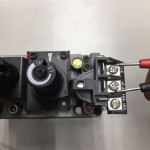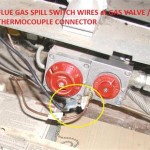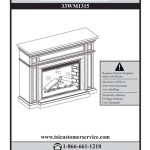Ventless Gas Fireplaces: An In-Depth Exploration
Ventless gas fireplaces, also known as vent-free gas fireplaces, represent a category of heating appliances designed to operate without the need for an external venting system such as a chimney or flue. This characteristic differentiates them significantly from traditional wood-burning fireplaces and vented gas fireplaces, offering increased installation flexibility and potential cost savings. However, their operation and safety considerations require careful evaluation before purchasing and installation.
The core functionality of a ventless gas fireplace relies on the principle of complete combustion. The appliance is engineered to burn natural gas or propane with a high degree of efficiency, minimizing the production of harmful byproducts such as carbon monoxide. Sensors and safety mechanisms are integrated into the design to monitor oxygen levels and shut off the gas supply if incomplete combustion is detected, mitigating the risk of carbon monoxide poisoning. The efficiency of combustion is a critical factor in determining the safety and suitability of a ventless gas fireplace for a given space.
The rise in popularity of ventless gas fireplaces stems from several factors, including their ease of installation, aesthetic appeal, and potential for supplemental heating. Eliminating the need for venting allows for installation in locations where traditional fireplaces are impractical or impossible to install. This ease of installation translates to lower installation costs, as there are no requirements for costly chimney construction or modification. Furthermore, the wide variety of styles and designs available ensures that ventless gas fireplaces can be integrated into various interior design schemes, providing both warmth and visual appeal.
Despite these advantages, it is imperative to understand the potential drawbacks and safety requirements associated with ventless gas fireplaces. Proper installation, adherence to manufacturer guidelines, and a clear understanding of ventilation needs are crucial for safe and efficient operation. Regular maintenance and inspection are also essential to ensure that the appliance continues to function correctly and that safety mechanisms remain operational.
The following sections will delve into key aspects of ventless gas fireplaces, including their functionality, safety considerations, installation requirements, maintenance procedures, and regulatory compliance. By understanding these factors, consumers can make informed decisions about whether a ventless gas fireplace is the right choice for their heating and aesthetic needs.
Understanding the Mechanics of Ventless Gas Fireplaces
Ventless gas fireplaces achieve their vent-free operation through meticulous engineering focused on complete combustion. The combustion process involves the reaction of natural gas or propane with oxygen to produce heat, water vapor, and carbon dioxide. In vented fireplaces, the combustion byproducts are expelled from the building through a chimney or flue. However, in ventless fireplaces, these byproducts are released directly into the living space.
To ensure safety, ventless gas fireplaces are equipped with an Oxygen Depletion Sensor (ODS). This sensor constantly monitors the oxygen levels in the room. If the oxygen level drops below a predetermined threshold, which indicates incomplete combustion and the potential for carbon monoxide production, the ODS triggers a safety shut-off mechanism that cuts off the gas supply to the fireplace. This safety feature is paramount to preventing carbon monoxide poisoning.
The design of the burner plays a significant role in achieving complete combustion. Ventless gas fireplaces utilize advanced burner designs that promote efficient mixing of gas and air, maximizing the combustion efficiency and minimizing the production of harmful byproducts. The burner design is also optimized to create a realistic flame appearance, enhancing the aesthetic appeal of the fireplace.
The size and BTU (British Thermal Unit) output of a ventless gas fireplace must be carefully matched to the size of the room in which it will be installed. Over-sizing the fireplace can lead to excessive heat output and potentially create uncomfortable or unsafe conditions. Manufacturer guidelines typically specify the maximum room size for a given BTU rating. It is crucial to adhere to these guidelines to ensure safe and efficient operation.
The use of propane or natural gas as fuel affects the overall performance and efficiency of the fireplace. Natural gas is generally considered to be a cleaner-burning fuel than propane, but both require proper combustion to minimize emissions. Regular maintenance and cleaning of the burner are essential to ensure optimal performance and efficiency, regardless of the fuel type used.
Addressing Safety Concerns and Regulatory Compliance
The safety of ventless gas fireplaces is a primary concern and is addressed through a combination of engineering design, safety features, and regulatory compliance. The American National Standards Institute (ANSI) and other regulatory bodies have established stringent standards for the design, manufacture, and testing of ventless gas fireplaces. These standards aim to ensure that these appliances meet specific safety requirements and minimize the risk of carbon monoxide poisoning and other hazards.
Carbon monoxide (CO) is a colorless, odorless, and poisonous gas that can be produced by incomplete combustion of fuels such as natural gas and propane. Exposure to high levels of CO can lead to serious health problems, including death. The ODS system in ventless gas fireplaces is designed to prevent the buildup of CO by shutting off the gas supply if oxygen levels drop too low. Regular testing and maintenance of the ODS system are essential to ensure its proper functioning.
Proper ventilation is also crucial for safe operation, even though ventless fireplaces do not require a dedicated vent. Manufacturers typically recommend opening a window or door slightly while the fireplace is in operation to ensure adequate air circulation. This helps to prevent the buildup of moisture and combustion byproducts in the room. Insufficient ventilation can lead to increased levels of humidity and potentially contribute to indoor air quality problems.
Building codes and regulations regarding the installation and use of ventless gas fireplaces vary by location. It is essential to consult with local building officials and obtain any necessary permits before installing a ventless gas fireplace. Some jurisdictions may restrict or prohibit the use of ventless gas fireplaces due to concerns about indoor air quality and safety. Compliance with local building codes is mandatory to ensure the legality and safety of the installation.
The use of carbon monoxide detectors is strongly recommended in any home where a ventless gas fireplace is installed. These detectors provide an additional layer of protection by alerting occupants to the presence of CO, even if the ODS system fails to function correctly. Regular testing of carbon monoxide detectors is essential to ensure that they are working properly.
Installation, Maintenance, and Best Practices
The proper installation of a ventless gas fireplace is critical for its safe and efficient operation. While ventless fireplaces are generally easier to install than vented fireplaces, it is still recommended to have the installation performed by a qualified professional. A professional installer will ensure that the fireplace is installed according to manufacturer's instructions and local building codes.
Before installation, it is essential to inspect the fireplace for any damage that may have occurred during shipping or handling. Ensure that all components are present and that the fireplace is suitable for the intended location. The installation site should be free of flammable materials and should provide adequate clearance around the fireplace.
Connecting the fireplace to the gas supply must be done by a licensed gas fitter. The gas supply line should be properly sized and installed according to local codes. A shut-off valve should be installed near the fireplace to allow for easy disconnection of the gas supply for maintenance or repairs.
Regular maintenance is essential to ensure the continued safe and efficient operation of a ventless gas fireplace. The burner should be cleaned periodically to remove dust, dirt, and other debris that may interfere with combustion. The ODS system should be inspected and tested regularly to ensure that it is functioning properly. The fireplace should also be inspected for any signs of damage or wear.
During maintenance, it is important to follow the manufacturer’s instructions carefully. Use only approved cleaning products and replacement parts. Do not attempt to repair the fireplace yourself unless you are a qualified technician. If you notice any unusual odors, noises, or performance issues, contact a qualified service technician for assistance.
Best practices for using a ventless gas fireplace include operating the fireplace according to the manufacturer's instructions, ensuring adequate ventilation, and avoiding the use of the fireplace for extended periods of time. Do not use the fireplace as a primary source of heat. Avoid placing flammable materials near the fireplace. Regularly inspect the fireplace for any signs of damage or wear. By following these best practices, you can help ensure the safe and efficient operation of your ventless gas fireplace.
:max_bytes(150000):strip_icc()/ventless-gas-fireplaces-4160746-hero-f9d4bdcd9bd446eb84406de306f790ba.jpg?strip=all)
How To Pick Out A Ventless Gas Fireplace

What Is A Ventless Gas Fireplace Experts In Gaithersbutg Md

Ventless Gas Fireplace Propane

Ventless Gas Fireplace Vent Free Modern

What Is A Ventless Gas Fireplace Dorr Oil

Vent Free Archives SÓlas Contemporary Fireplaces

Duluth Forge Dual Fuel Ventless Gas Fireplace 32 000 Btu Remote Control Antique White Finish Com

Vent Free Gas Fireplaces Inserts Stoves Napolis Godby Hearth And Home

Are Vent Free Gas Fireplaces Safe Ventless

Duluth Forge 45 In Dual Fuel Ventless Gas Fireplace With Mantel 32 000 Btu Remote Control Antique White At Tractor Supply Co
Related Posts

